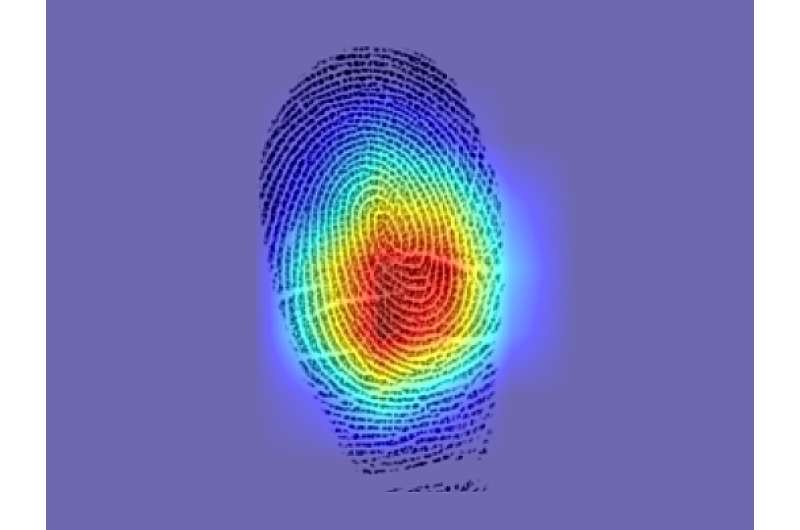
From “Law and Order” to “CSI,” not to mention real life, investigators have used fingerprints as the gold standard for linking criminals to a crime. But if a perpetrator leaves prints from different fingers in two different crime scenes, these scenes are very difficult to link, and the trace can go cold.
It’s a well-accepted fact in the forensics community that fingerprints of different fingers of the same person—”intra-person fingerprints”—are unique and, therefore, unmatchable.
A team led by Columbia Engineering undergraduate senior Gabe Guo challenged this widely held presumption. Guo, who had no prior knowledge of forensics, found a public U.S. government database of some 60,000 fingerprints and fed them in pairs into an artificial intelligence-based system known as a deep contrastive network. Sometimes the pairs belonged to the same person (but different fingers), and sometimes they belonged to different people.
Over time, the AI system, which the team designed by modifying a state-of-the-art framework, got better at telling when seemingly unique fingerprints belonged to the same person and when they didn’t. The accuracy for a single pair reached 77%. When multiple pairs were presented, the accuracy shot significantly higher, potentially increasing current forensic efficiency by more than tenfold.
The project, a collaboration between Hod Lipson’s Creative Machines lab at Columbia Engineering and Wenyao Xu’s Embedded Sensors and Computing lab at University at Buffalo, SUNY, was published today in Science Advances.
Study findings challenge–and surprise–forensics community
Once the team verified their results, they quickly sent the findings to a well-established forensics journal, only to receive a rejection a few months later. The anonymous expert reviewer and editor concluded that “It is well known that every fingerprint is unique,” and therefore, it would not be possible to detect similarities even if the fingerprints came from the same person.
The team did not give up. They doubled down on the lead, fed their AI system even more data, and the system kept improving. Aware of the forensics community’s skepticism, the team opted to submit their manuscript to a more general audience. The paper was rejected again, but Lipson, who is the James and Sally Scapa Professor of Innovation in the Department of Mechanical Engineering and co-director of the Makerspace Facility, appealed.
“I don’t normally argue editorial decisions, but this finding was too important to ignore,” he said. “If this information tips the balance, then I imagine that cold cases could be revived and even that innocent people could be acquitted.”
While the system’s accuracy is insufficient to decide a case officially, it can help prioritize leads in ambiguous situations. After more back and forth, the paper was finally accepted for publication by Science Advances.
A new kind of forensic marker to precisely capture fingerprints
One of the sticking points was the following question: What alternative information was the AI actually using that has evaded decades of forensic analysis? After carefully visualizing the AI system’s decision process, the team concluded that the AI was using a new forensic marker.
“The AI was not using ‘minutiae,’ which are the branchings and endpoints in fingerprint ridges—the patterns used in traditional fingerprint comparison,” said Guo, who began the study as a first-year student at Columbia Engineering in 2021. “Instead, it was using something else, related to the angles and curvatures of the swirls and loops in the center of the fingerprint.”
Columbia Engineering senior Aniv Ray and Ph.D. student Judah Goldfeder, who helped analyze the data, noted that their results are just the beginning. “Just imagine how well this will perform once it’s trained on millions instead of thousands of fingerprints,” said Ray.
The team is aware of potential biases in the data. The authors present evidence that indicates that the AI performs similarly across genders and races where samples were available. However, they note that more careful validation needs to be done using datasets with broader coverage if this technique is to be used in practice.
Transformative potential of AI in a well-established field
This discovery is an example of more surprising things to come from AI, notes Lipson, “Many people think that AI cannot really make new discoveries–that it just regurgitates knowledge,” he said. “But this research is an example of how even a fairly simple AI, given a fairly plain dataset that the research community has had lying around for years, can provide insights that have eluded experts for decades.”
He added, “Even more exciting is the fact that an undergraduate student, with no background in forensics whatsoever, can use AI to challenge a widely held belief of an entire field successfully. We are about to experience an explosion of AI-led scientific discovery by non-experts, and the expert community, including academia, needs to get ready.”
More information:
Gabriel Guo et al, Unveiling Intra-Person Fingerprint Similarity via Deep Contrastive Learning, Science Advances (2024). DOI: 10.1126/sciadv.adi0329. www.science.org/doi/10.1126/sciadv.adi0329
Columbia University School of Engineering and Applied Science
Citation:
AI discovers that not every fingerprint is unique (2024, January 10)
retrieved 11 January 2024
from https://techxplore.com/news/2024-01-ai-fingerprint-unique.html
This document is subject to copyright. Apart from any fair dealing for the purpose of private study or research, no
part may be reproduced without the written permission. The content is provided for information purposes only.










